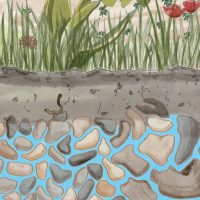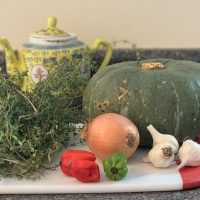7 Foods That Grow in Unexpected Ways
Nature is amazing!
1) Pineapple
This fruit grows in tropical climates on large spiky plants. It is part of the Bromeliaceae family which is very diverse and also includes epiphytes, what we call “air plants”. When the pineapple is flowering, it is a cluster of beautiful tiny blue-purple flowers which are pollinated by hummingbirds and often by hand for large-scale production.
How cute is this baby pineapple!

Pineapple flowering in Jamaica. / Lisa Morgan

Photo: Lisa Morgan
Each one of those flowers above formed into a piece of the fruit. This is why you can eat a very ripe pineapple by pulling it apart.
2) Kiwi
I thought Kiwi fruit grew on trees and that they grew only in warm climates.
Recently, I received a gardening catalogue and saw Kiwi listed as something I could grown here in Zone 5. AND… it’s a VINE, not a tree. Huh!
3) Peanuts
Peanuts are legumes, like peas, but, unlike peas, they grow underground like a tuber.
4) Cashews
Cashews are nuts that grow on trees but they don’t look like most tree nuts while they’re growing.
“Ripe cashew apples” Abhishek Jacob/ CC
The cashew that you enjoy is hidden in that green thing dangling under what looks like a yellow apple called the “cashew apple”. When the actual cashew is ready, the cashew apple is too fragile to import, which is why you don’t see those in stores. But, locally, people will make juice and alcohol from the cashew apple.
As for the seed or nut, it is in a shell that contains poisonous or allergenic compounds. That’s why Cashews are not sold in their shell to consumers. When we lived in Jamaica, my brother and dad tried to roast some cashew they had picked. The gas that was released when they opened the oven made them swell up like a balloon. From Wikipedia: “The seed is surrounded by a double shell containing an allergenic phenolic resin, anacardic acid, a potent skin irritant chemically related to the better-known allergenic oil urushiol which is also a toxin found in the related poison ivy.” (1)
5) Chickpeas
These delicious protein-packed legumes are not only adorable (come on, they totally are!) they grow a little different that other legumes. I guess you could say they’re a little prissy and don’t share their pod. Just ONE pea grows inside the pod on plant, which looks very fern-like.

Related: 50 Foods We Should Be Eating
6) Vanilla
Vanilla pods come from orchids. The vanilla orchid has no scent to attract pollinating insects. The orchid must be pollinated by humans within a very short time window or there will be no pod. That is one of the reasons why vanilla pods are so expensive.
The pods are long and green when they are harvested and must dry out into the shriveled dark brown/black pods you see in stores before they give you that wonderful flavour you love. Vanilla extract is made from vanilla pods steeped in alcohol, which extracts the flavour. If you want to try something different, you can make your own extract in the alcohol of your choice like bourbon or dark rum instead of just vodka.

Image: Sunil Elias/CC
7) Brussels Sprouts
I’m going to grow these in my garden this year because they’re delicious but also because they look sooooo cool! ( At least, I’m going to attempt it. I have not been successful with brussels sprout’s cousins: broccoli, cauliflower or cabbage.)

Maddie Moat/YouTube
Bonus) Loofa
Ok, this isn’t a food but it fits under the “I didn’t know it came from there!” file.

Insider/YouTube
Loofa is not a dried out sea creature like a sea sponge. It is actually a type of gourd. Check out how they are harvested:







